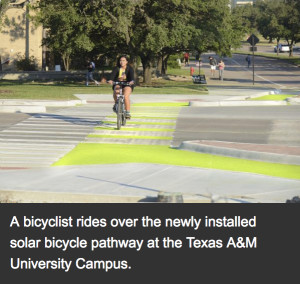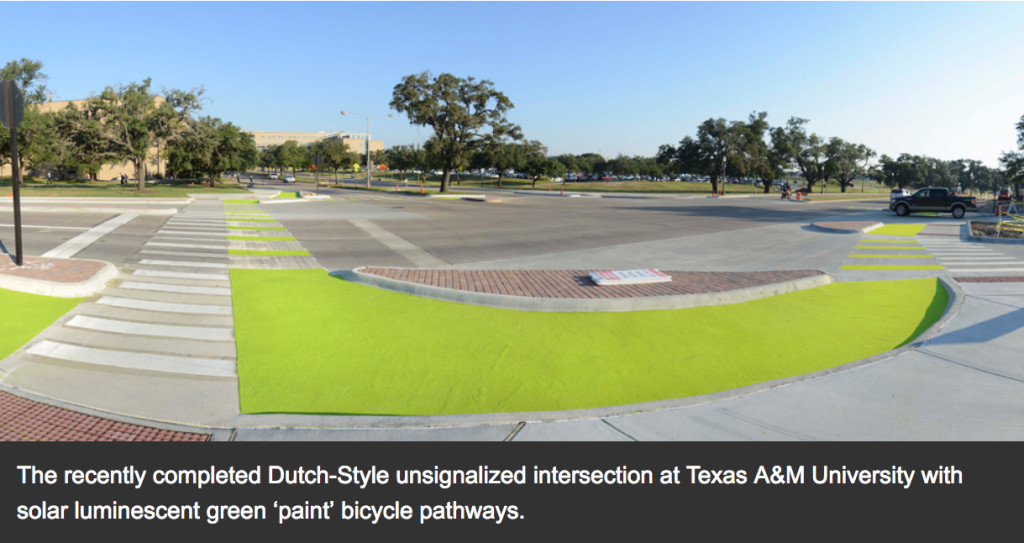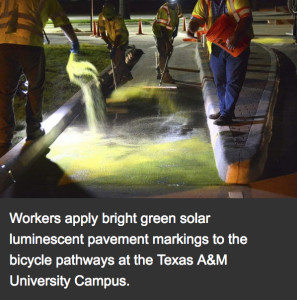CE 330 Epoxy Binder contributes the first solar bike pathway.

First in U.S. Dutch-Style Unsignalized Intersection Installed at Texas A&M University with Solar Luminescent Green ‘Paint’ Bicycle Pathways
Texas A&M Transportation Institute (TTI) and Texas A&M University Transportation Services completed construction on a first-of-its-kind non-signalized, Dutch-style intersection Oct. 3. The protected intersection includes bright green solar luminescent pavement markings used to delineate the bicycle pathways—also a first use in the United States. In this innovation, the illuminating green pavement marking keeps the pathways lit for the cyclists by storing solar energy during the day and emitting light during nighttime.
The Dutch Junction, which was developed in the Netherlands and refined in other locations, moves bicyclists in front of vehicles at the intersection, increasing the protection for cyclists. The key to its design is the islands at the intersection corners, which separate cars and cyclists turning right; they also move cyclists traveling straight into the view of automobiles and away from their blind spot.
The protected intersection with solar luminescent bike lanes is located at the corner of Bizzell and Ross Streets, an unsignalized on-campus crossing with high pedestrian, bicycle and vehicle volumes. With nearly 70,000 students, faculty and staff traveling to and from campus daily, the intersection will enhance the safe flow of vehicular, bicycle and pedestrian traffic in this area.
“We are excited to bring this kind of innovation and technology to the Texas A&M campus,” said Associate Vice President Peter Lange, Transportation Services. “We are confident the protected intersection will provide an added level of safety for bicyclists and drivers traveling in this area on campus.”
This most recent project is another step taken by the university to ensure the safety of bicyclists on campus. In the fall of 2015, Texas A&M gained recognition for its overall effort to create a more bike-friendly environment (community) by garnering the prestigious Bike Friendly University designation.
“This is an excellent example of opportunities for real-world, high-impact learning that we provide to our students,” said M. Katherine Banks, vice chancellor and dean of Texas A&M Engineering. “This innovative transportation approach is being deployed for the first time in the United States and our students will play a critical role in the implementation.”
The solar pavement markings are one of the first implementations under the Texas A&M Transportation Institute’s Campus Transportation Technology Initiative, which explores new technologies to advance campus transportation operations and future planning priorities. By partnering with companies to bring technologies and innovation to the forefront of the campus transportation ecosystem, Texas A&M and TTI desire to provide transportation solutions to enhance the quality of life for everyone on campus. The goals of this initiative include greater mobility, improved safety, enhanced connectivity and more efficient services.
A key component of the Campus Transportation Technology Initiative is student involvement. More than 3,000 Texas A&M Engineering undergraduate students will use the implementation as a case study of a civil engineering design challenge. The students will have the opportunity to go through the intersection as a motorist, pedestrian, or bicyclist and answer a short survey about their opinions on the innovations in the intersection design and delineation.
Additionally, upperclassmen in a research methodology course at the Texas A&M College of Architecture’s Department of Landscape Architecture and Urban Planning will perform a class project on the effectiveness of the Dutch junction on intersection safety and mobility for cyclists and pedestrians.


